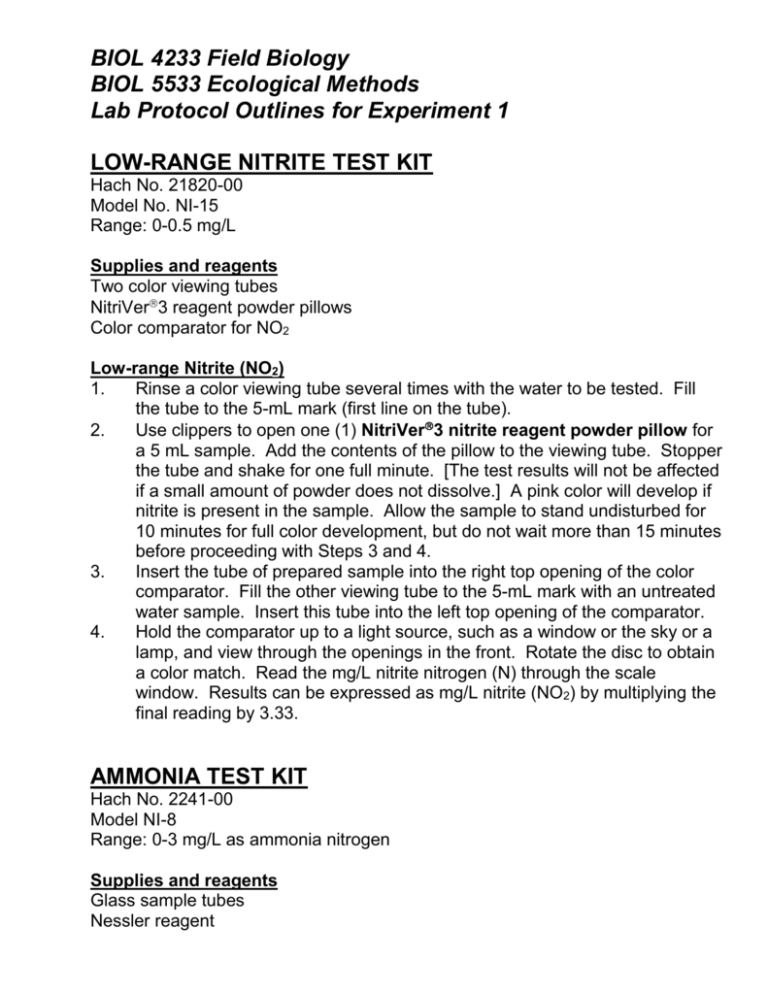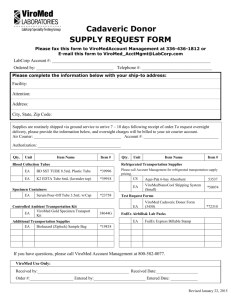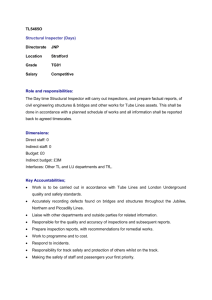Procedure
advertisement

BIOL 4233 Field Biology BIOL 5533 Ecological Methods Lab Protocol Outlines for Experiment 1 LOW-RANGE NITRITE TEST KIT Hach No. 21820-00 Model No. NI-15 Range: 0-0.5 mg/L Supplies and reagents Two color viewing tubes NitriVer3 reagent powder pillows Color comparator for NO2 Low-range Nitrite (NO2) 1. Rinse a color viewing tube several times with the water to be tested. Fill the tube to the 5-mL mark (first line on the tube). 2. Use clippers to open one (1) NitriVer3 nitrite reagent powder pillow for a 5 mL sample. Add the contents of the pillow to the viewing tube. Stopper the tube and shake for one full minute. [The test results will not be affected if a small amount of powder does not dissolve.] A pink color will develop if nitrite is present in the sample. Allow the sample to stand undisturbed for 10 minutes for full color development, but do not wait more than 15 minutes before proceeding with Steps 3 and 4. 3. Insert the tube of prepared sample into the right top opening of the color comparator. Fill the other viewing tube to the 5-mL mark with an untreated water sample. Insert this tube into the left top opening of the comparator. 4. Hold the comparator up to a light source, such as a window or the sky or a lamp, and view through the openings in the front. Rotate the disc to obtain a color match. Read the mg/L nitrite nitrogen (N) through the scale window. Results can be expressed as mg/L nitrite (NO2) by multiplying the final reading by 3.33. AMMONIA TEST KIT Hach No. 2241-00 Model NI-8 Range: 0-3 mg/L as ammonia nitrogen Supplies and reagents Glass sample tubes Nessler reagent Color comparator for NH3 Ammonia (NH3) 1. Fill the two glass sample tubes to the 5-mL mark (first line on the tubes) with the water to be tested. 2. Add three (3) drops of Nessler reagent to one of the tubes, and swirl to mix. 3. Allow at least 10, but not more than 25, minutes for color development. If ammonia nitrogen is present in the sample, a yellow color will develop. 4. Insert the tube of prepared sample into the right top opening (inside opening) of the color comparator. 5. Insert the glass sample tube containing the untreated sample into the left top opening (outside opening) of the comparator. 5. Hold the comparator up to a light source such as the sky, a window or lamp and view through the two openings in the front. Rotate the disc to obtain a color match. Read the mg/L ammonia nitrogen (N) through the scale window. Results can be expressed as mg/L ammonia (NH3) by multiplying the final reading by 1.2. NITRATE TEST KIT Hach No. 14161-00 Model NI-14 Range: 0-10 mg/L Supplies and reagents Color viewing tubes Color comparator for NO3 NitraVer6 nitrate reagent powder pillows NitriVer3 nitrite reagent powder pillows Low-range Nitrate (NO3) (0-1 mg/L) 1. Fill one of the color viewing tubes to the lowest mark with the sample to be tested. Stopper the tube and shake vigorously. Empty the tube and repeat this procedure. 2. Fill the color viewing tube to the lowest mark with the sample. 3. Use clippers to open one NitraVer6 nitrate reagent powder pillow. Add the contents of the pillow to the sample to be tested. Stopper the tube and shake for three minutes. Allow the sample to stand undisturbed for an additional 30 seconds. Unoxidized particles of cadmium metal will remain in the sample and settle to the bottom of the viewing tube. 4. Pour the prepared sample into a second color viewing tube carefully so that the cadmium particles remain in the first tube. 5. Use clippers to open one NitriVer3 nitrite reagent powder pillow. Add the contents of the pillow to the sample. Stopper the tube and shake for 30 6. 7. 8. seconds. A red color will develop if nitrate is present. Allow at least 10 minutes, but not more than 20 minutes, before completing Steps 6-8. Insert the tube of prepared sample into the right (inside) top opening of the color comparator. Rinse the unoxidized cadmium metal from the color viewing tube used in Step 2. Fill to the mark with the original water sample and place in the left (outside) top opening of the comparator. Hold the comparator up to light source such as the sky, a window or lamp and view through the openings in front. Rotate the disc to obtain a color match. Read the mg/L nitrate nitrogen through the scale window. To obtain the results as mg/L nitrate (NO3), multiply the reading on the scale by 4.4. High-range Nitrate (NO3) (0-10 mg/L) [run this test ONLY if the first test yields no results] 1. Fill one of the color viewing tubes to the mark with deionized water. Stopper the tube and shake vigorously. Empty the tube and repeat this procedure. 2. Rinse the plastic dropper with the sample to be tested, then fill to the 0.5mL mark. Add the contents of the dropper to the rinsed color viewing tube. 3. Add deionized water to the mark. 4. Use clippers to open one NitraVer6 nitrate reagent powder pillow. Add the contents of the pillow to the sample to be tested. Stopper the tube and shake for three minutes. Allow the sample to stand undisturbed for an additional 30 seconds. Unoxidized particles of cadmium metal will remain in the sample and settle to the bottom of the viewing tube. 5. Pour the prepared sample into a second color viewing tube carefully so that the cadmium particles remain in the first tube. 6. Use clippers to open one NitriVer3 nitrite reagent powder pillow. Add the contents of the pillow to the sample. Stopper the tube and shake for 30 seconds. A red color will develop if nitrate is present. Allow at least 10 minutes, but not more than 20 minutes, before completing Steps 7-9. 7. Insert the tube of prepared sample into the right (inside) top opening of the color comparator. 8. Rinse the unoxidized cadmium metal from the color viewing tube used in Step 2. Fill to the mark with the original water sample and place in the left (outside) top opening of the comparator. 9. Hold the comparator up to light source such as the sky, a window or lamp and view through the openings in front. Rotate the disc to obtain a color match. Read the mg/L nitrate nitrogen through the scale window. To obtain the results as mg/L nitrate (NO3), multiply the reading on the scale by 4.4. PHOSPHATE (ORTHOPHOSPHATE) TEST KIT Hach No. 2250-01 Model No. PO-24 Range: 0-50 mg/L Supplies and reagents Square mixing bottle Two color viewing tubes PhosVer3 reagent powder pillows Color comparator for PO4 Low-range Orthophosphate (PO4): 0-1 mg/L 1. Fill the square mixing bottle to the 20-mL mark with the water to be tested. 2. Open one (1) PhosVer3 phosphate reagent powder pillow. Add the contents of the pillow to the mixing bottle and swirl. Allow at least two but not more than 10 minutes for color development. If phosphate is present, a blue violet color will develop. 3. Insert the lengthwise viewing adapter into the color comparator. 4. Fill one sample viewing tube to about one inch below the top of the tube. Place this tube into the comparator in the inside tube slot. 5. Fill the other sample tube with untreated sample water and place into the comparator in the outside tube slot. 6. Hold the comparator up to a light source, such as a window or the sky or a lamp, and view through the openings in the front. Rotate the disc to obtain a color match. Read the mg/L phosphate through the scale window. 7. Divide the reading from the scale window by 50 to obtain the mg/L phosphate (PO4). Medium-range Orthophosphate (PO4): 0-5 mg/L [Run this test ONLY if the result of the first test is over-range] 1. Perform Steps 1 and 2 of the low-range procedure above. 2. Fill one of the color viewing tubes to the lowest mark with the prepared sample (approximately 5 mL). Insert this tube into the right top opening (inside slot) or the color comparator). 3. Fill the other tube to the lowest mark with untreated sample (approximately 5 mL). Insert this tube into the left top opening (outside slot) of the color comparator. 4. Hold the comparator up to a light source, such as a window or the sky or a lamp, and view through the openings in the front. Rotate the disc to obtain a color match. Read the mg/L phosphate through the scale window. 5. Divide the reading from the scale window by 10 to obtain the mg/L phosphate (PO4). High-range Orthophosphate (PO4): 0-50 mg/L [Run this test ONLY if the result of the second test is over-range] 1. Rinse the square mixing bottle with demineralized water. 2. Add 2.0 mL of the water to be tested by twice filling the dropper to the 1mL mark with the sample and discharging the contents into the mixing bottle. 3. Add demineralized water to the mixing bottle to the 20-mL mark. Swirl to mix. 4. Open one (1) PhosVer3 phosphate reagent powder pillow. Add the contents of the pillow to the mixing bottle and swirl. Allow at least two but not more than 10 minutes for development of a blue violet color. 5. Follow Steps 2 and 3 of the medium-range procedure. 6. Hold the comparator up to a light source, such as a window or the sky or a lamp, and view through the openings in the front. Rotate the disc to obtain a color match. Read the mg/L phosphate (PO4) through the scale window. HACH Company sension5 Conductivity Meter Conductivity (S/cm or mS/cm) Total Dissolved Solids (TDS) (mg/L) Salinity (o/oo) 1. Press “I/exit” to turn on the meter. (After it auto calibrates, the meter will display the last value it read.) 2. Place the probe into the sample water, being careful not to submerge the taped section. 3. Press “cond”, then “read”. Wait until the meter beeps and the lock symbol comes on, then read the sample conductivity. The units will be in S/cm or mS/cm, depending on the conductivity of the sample. Be sure to note which units are displayed. 4. Press “TDS”, then “read”. Wait until the meter beeps and the lock symbol comes on, then read the sample TDS (total dissolved solids). The units will be in mg/L. 5. Press “sal”, then “read”. Wait until the meter beeps and the lock symbol comes on, then read the sample salinity. The units will be in parts per thousand (o/oo). 6. Remove the probe from the sample. Press “I/exit” to turn the meter off. TURBIDITY Absorptometric Method Hach Method 8237 Range: 0-1000 FAU Reagents and Supplies DR/890 colorimeter 25-mL sample cells Procedure 1. Enter the stored program number for turbidity. a. Press PRGM. b. Press 95 ENTER. 2. Fill a sample cell with 10 ml of deionized water (the blank). 3. Place the blank into the cell holder. Tightly cover the sample cell with the instrument cap. 4. Press ZERO. The display will show 0 FAU. 5. Mix the sample water well. Fill another sample cell with 10 ml of the sample water. 6. Place the sample cell into the cell holder. Tightly cover the sample cell with the instrument cap. 7. Press READ. The result in Formazin Attenuation Units (FAU) will be displayed. APPARENT COLOR APHA Platinum-Cobalt Standard Method Hach Method 8025 Range: 0-500 Platinum-Cobalt color units Reagents and Supplies DR/890 colorimeter 25-mL sample cells Procedure 1. Enter the stored program number for turbidity. a. Press PRGM. b. Press 19 ENTER. 2. Fill a sample cell with 10 ml of deionized water (the blank). 3. Place the blank into the cell holder. Tightly cover the sample cell with the instrument cap. 4. Press ZERO. The display will show 0 PtCo. 5. Mix the sample water well. Fill another sample cell with 10 ml of the sample water. 6. Place the sample cell into the cell holder. Tightly cover the sample cell with the instrument cap. 7. Press READ. The result in Platinum-Cobalt color units (PtCo) will be displayed.






